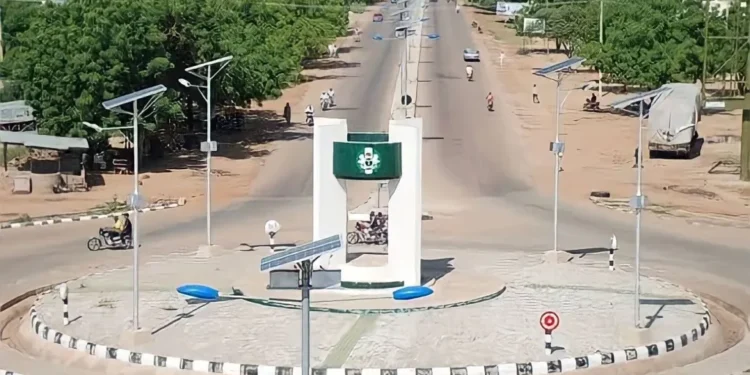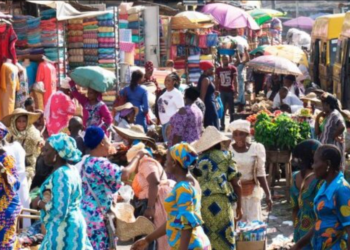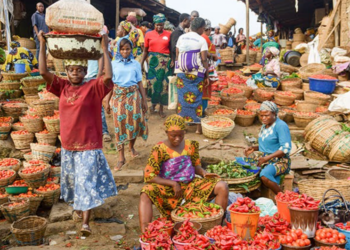Nigeria’s headline inflation rate eased to 21.88% in July 2025, down from 22.22% in June.
This is according to the National Bureau of Statistics (NBS) July 2025 Consumer Price Index (CPI) report released on Friday.
The report, which tracks the average change in prices of goods and services—including both food and non-food items—also highlights the states with the highest and lowest all-items inflation rates, offering insight into regional cost-of-living disparities.
Below is a breakdown of the 10 states with the lowest inflation rates in July 2025, according to the NBS:
10. Rivers 20.03%
In tenth place is oil-rich Rivers State, located in Nigeria’s South-South geo-political zone.
Rivers State’s headline inflation stood at 20.03% in July 2025, down from 21.2% in June—a 0.6% month-on-month decline. However, food inflation rose to 18.9% in July from 17.7% in June, marking a 2.1% month-on-month increase.
While defending the state’s 2025 budget at the National Assembly in June, Sole Administrator Ibok-Ete Ibas stressed the need to “respond to the urgent needs of Rivers State under the current emergency.”
The budget earmarked N31.4 billion for various initiatives, including counterpart funding for the Rural Access and Agricultural Marketing Programme and investments aimed at boosting local production of rice, cassava, and oil palm—part of broader measures to curb food inflation.
9. Jigawa 19.41%
Jigawa state, located in Nigeria’s North-West region, recorded an annual inflation rate of 19.41% in July 2025, slightly down from 19.6% in June.
However, the state’s food inflation climbed to 18.9% in July from 15.5% in June. The drop in overall inflation is largely credited to recent government interventions.
Yet, the uptick in food inflation—despite support for smallholder farmers—demonstrates the need for greater focus on long-term, large-scale agricultural investments, particularly in food production.
8. Bauchi 18.90%
Bauchi State, in North-East Nigeria, recorded an annual inflation rate of 18.90% in July 2025, down from 21.7% in June.
Food inflation also declined sharply, falling to 15.5% in July from 21.3% in June.
In May 2024, the Bauchi State Government announced measures aimed at controlling food prices as part of efforts to curb inflation and ease the financial burden on residents.
The Bauchi State Commissioner of Local Government and Chieftaincy Affairs, Ahmad Sarki Aliyu Jalam, said at a meeting with religious leaders at the ministry, “The measure would address illegal businesses of foodstuff and other basic needs in the state.
“Bauchi State Government is worried about the activities of some business owners, especially foodstuff dealers,” which, according to him, “creates unnecessary hardship among the citizens, while assuring that “action must be taken.”
7. Ondo 18.43%
Ondo State, in Nigeria’s South-West region, ranked 7th in July 2025, slipping from 6th place in June among the country’s most budget-friendly states.
Its annual inflation rate stood at 18.43% in July, a slight increase from 18.2% recorded in June. According to NBS data, food inflation in the state was 17.9% in July, up marginally from 17.8% in June.
Governor Lucky Aiyedatiwa has repeatedly reaffirmed his administration’s commitment to large-scale farming. The state government is backing mechanised farms, including projects in partnership with private investors, notably in Ore, the headquarters of Odigbo Local Government Area.
6. Gombe 17.41%
Gombe State, located in Nigeria’s North-East geo-political zone, recorded a headline inflation rate of 17.41% in July 2025. This is a drop from 18.7% recorded in June 2025, according to NBS data.
Food inflation in the state was 20.3% in July 2025, which is a drop from 22.1% recorded in June.
The state is one of the beneficiaries of the £204 million United Kingdom-funded Foreign, Commonwealth and Development Office (FCDO) programme for climate-resilient agricultural market development in Nigeria.
As part of efforts to boost livestock production and enhance food security, Governor Inuwa Yahaya recently announced a N50 billion water canalisation project. The initiative will channel water from the River Gongola to the Wawa-Zange Grazing Reserve, directly benefiting over one million pastoralists and indirectly impacting more than five million people.
Analysts attribute the drop in food inflation to some recent interventions from the state government and improved security situation.
5. Sokoto 16.46%
Sokoto, in the North-West, emerged as one of the most affordable northern states with an inflation rate of 16.46% in July 2025. This represents a slight decrease from 16.5% recorded in June 2025.
The state recorded a 17.9% food inflation rate in the month under review, a drop from 15.3% in June 2025.
The Governor of Sokoto State, Ahmed Aliyu Sokoto, as part of strategies to boost agriculture and food security, has consistently distributed free fertilizers and agricultural inputs to farmers across the state’s 23 local government areas to support dry season farming since the inception of his administration.
The state government also completed the Kware Irrigation Scheme covering 450 hectares. The scheme is expected to support rice and onion farming, engaging around 500 farmers and generating significant employment along the value chain.
The state’s relatively low transport costs may have contributed to this figure, which kept its overall inflation rate down in July.
4. Adamawa 16.30%
Adamawa State, located in North-East Nigeria, recorded an annual inflation rate of 16.3% in July, down from 16.9% in June 2025.
In July, food inflation in the state stood at 9.9%, down from 10.9% in June 2025.
The Adamawa state Governor, Ahmadu Fintiri, recently launched a $525,000 World Bank agricultural intervention project to support farmers, enhance food production, and address the impacts of climate change as part of efforts to improve food security.
The significant drop in the inflation rate contributed to Adamawa being considered one of the most economically livable states in Nigeria in July 2025.
3. Katsina 15.64%
Katsina State in the North-West occupies the third position in this month’s ranking. The state recorded an annual inflation rate of 15.64% in July 2025. This is a drop from 17.5% in June.
Also, according to NBS data, food inflation in Katsina stood at 6.6%, an increase from 6.2% in June.
In May 2025, Governor of Katsina Dr. Dikko Umar Radda launched the distribution of 20,000 metric tons of fertiliser for the 2025 wet season farming cycle. He announced that farmers would receive high-quality fertiliser at a subsidised rate of N20,000 per bag, aimed at boosting crop yields and farmer incomes.
Additionally, the federal government approved a N25 billion intervention fund for the newly commissioned Katsina Agricultural Mechanized Centre, further strengthening the state’s agricultural infrastructure.
Katsina’s relatively low food inflation, combined with proactive policies and investments in agriculture, has contributed to its status as one of the most affordable states to live in as of July 2025.
2. Zamfara 12.75%
Dropping from the most affordable state in May to second position is Zamfara state. The state recorded an annual inflation rate of 12.75% in July, compared to 9.9% recorded in June.
The food inflation in the state stood at 14.7%, a significant drop from 26.2% recorded in June.
Some analysts say the recent drop in food inflation in the state is due largely to the relative improvement in the security situation in the state in recent times.
Zamfara State Governor Dauda Lawal launched the Zamfara State Pilot School Feeding Programme.
1. Yobe 11.43%
The most affordable state to live in Nigeria is Yobe. Located in the North-East geo-political zone of Nigeria, the state recorded an annual inflation rate of 11.43%. According to NBS data, this is a reduction from 13.5% recorded in June 2025.
Also, the food inflation rate in July 2025 for Yobe state stood at 15.1%, a drop from 17.9% recorded in June.
The drop in food inflation, analysts say, is largely due to the recent massive campaign by the state government for young people to engage in agricultural activities for food sufficiency and food security.
Also, there has been some improvement in the security situation in the state in recent months.

























But where’s Benue?